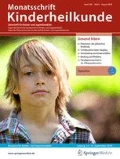Zusammenfassung
Epidemiologie und Pathogenese
Die Pneumonie gehört zu den häufigsten Infektionskrankheiten im Kindesalter und geht in Entwicklungsländern noch immer mit einer erheblichen Mortalität einher. Pneumokokken, mit einer Vielzahl an verschiedenen Serotypen, sind die häufigsten bakteriellen Erreger der ambulant erworbenen Pneumonie. Viruserreger, an erster Stelle das RSV („respiratory syncytial virus“), verursachen v. a. bei Kindern unter 5 Jahren bis zu 50 % der Pneumonien. Bei Kindern ab 5 Jahren treten Mycoplasma pneumoniae und Chlamydia-Spezies zunehmend häufiger auf.
Diagnose
Die Diagnose der Pneumonie wird in erster Linie aufgrund klinischer Kriterien gestellt, eine Röntgenuntersuchung des Thorax ist nur bei schwerem, kompliziertem Verlauf erforderlich.
Therapie
Bei stabilem klinischem Zustand und fehlender respiratorischer Insuffizienz ist eine ambulante Behandlung möglich. Bei Verdacht auf bakterielle Pneumonie gilt bei Kindern ohne Grunderkrankung eine Behandlung mit Aminopenizillinen (Amoxicillin p.o., Ampicillin i.v.) für 7 Tage als die Therapie der Wahl. Bei älteren Kindern mit Verdacht auf eine interstitielle Pneumonie sollten wegen der Bedeutung von Mycoplasma pneumoniae und Chlamydia-Spezies Makrolide eingesetzt werden.
Prognose
Insgesamt ist die Prognose der Pneumonie in Industrieländern gut. Gegenüber einigen Erregern der ambulant erworbenen Pneumonie, z. B. Pneumokokken, gibt es heute mit aktiven Impfungen eine wirksame und sichere Prophylaxe.
Abstract
Epidemiology and pathogenesis
Pneumonia is one of the most frequent infectious diseases among children and is still associated with a high mortality in developing countries. The most frequent bacterial pathogen causing community-acquired pneumonia (CAP) is Streptococcus pneumoniae with a large variety of different serotypes. Viral pathogens and most importantly respiratory syncytial virus (RSV) are responsible for up to 50 % of cases of pneumonia in children under 5 years of age. In children over 5 years old Mycoplasma pneumoniae and Chlamydia spp. are becoming increasingly more important.
Diagnosis
The diagnosis of pneumonia can primarily be made by clinical criteria and radiographs are only indicated in severe complicated diseases.
Therapy
In clinically stable children without respiratory insufficiency outpatient treatment is possible. In uncomplicated CAP the antibiotic treatment of choice is oral amoxicillin or intravenous ampicillin for at least 7 days. In older children with suspected atypical pneumonia due to Mycoplasma pneumoniae and Chlamydia spp. macrolides should be used as primary treatment.
Prognosis
The overall prognosis of pneumonia in developed countries is very good. Now and in the future the burden of pneumonia will be further decreased by safe vaccines which are effective at least against some of the most common pathogens.





Literatur
Harris M, Clark J, Coote N et al (2011) British Thoracic Society guidelines for the management of community acquired pneumonia in children: update 2011. Thorax [Suppl 2] 66:ii1–ii23
Heiskanen-Kosma T, Korppi M, Jokinen C et al (1998) Etiology of childhood pneumonia: serologic results of a prospective, population-based study. Pediatr Infect Dis J 17(11):986
Kohns M, Seyfarth J, Schramm D et al. (2013) Tuberkulose – Pathogenese und Wertigkeit immundiagnostischer Tests. Monatsschr Kinderheilkd 8
Liese J (2013) Pneumonie. In: Deutsche Gesellschaft für pädiatrische Infektiologie (Hrsg) DGPI Handbuch – Infektionen bei Kindern und Jugendlichen, 6. Aufl. Thieme, Stuttgart New York
Magdorf K (2013) Tuberkulose. In: Deutsche Gesellschaft für pädiatrische Infektiologie (Hrsg) DGPI Handbuch – Infektionen bei Kindern und Jugendlichen, 6. Aufl. Thieme, Stuttgart New York
Rudan I, Boschi-Pinto C, Biloglav Z et al (2008) Epidemiology and etiology of childhood pneumonia. Bull World Health Organ 86(5):408
Schaberg T, Bauer T, Castell S et al, Deutsches Zentralkomitee zur Bekämpfung der Tuberkulose (DZK), Deutsche Gesellschaft für Pneumologie und Beatmungsmedizin (DGP) (2012) Empfehlungen zur Therapie, Chemoprävention und Chemoprophylaxe der Tuberkulose im Erwachsenen- und Kindesalter. Pneumologie 66(03):133–171
Einhaltung ethischer Richtlinien
Interessenkonflikt. J. Liese, M. Abele-Horn, M. Beer, J. Forster, U. Heininger, D. Nadal, M. Rose und H. Scholz geben an, dass kein Interessenkonflikt besteht. Das vorliegende Manuskript enthält keine Studien an Menschen oder Tieren.
Author information
Authors and Affiliations
Corresponding author
Additional information
Teile dieses Beitrags orientieren sich an: Liese J (2013) Pneumonie. In: Deutsche Gesellschaft für pädiatrische Infektiologie (Hrsg) DGPI Handbuch – Infektionen bei Kindern und Jugendlichen, 6. Aufl. Thieme, Stuttgart New York
Rights and permissions
About this article
Cite this article
Liese, J., Abele-Horn, M., Beer, M. et al. Diagnose und Behandlung der Pneumonie im Kindesalter. Monatsschr Kinderheilkd 161, 703–712 (2013). https://doi.org/10.1007/s00112-013-2883-x
Published:
Issue Date:
DOI: https://doi.org/10.1007/s00112-013-2883-x

